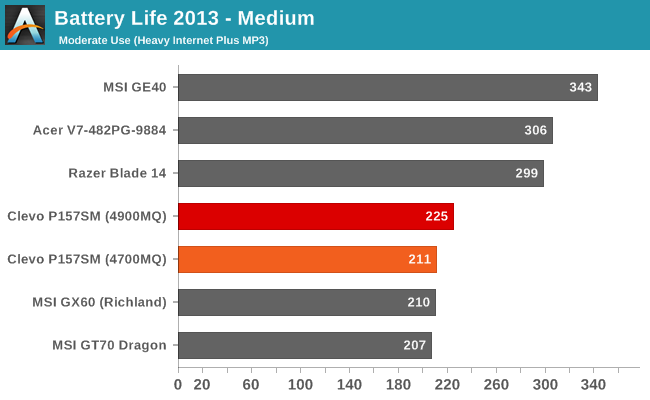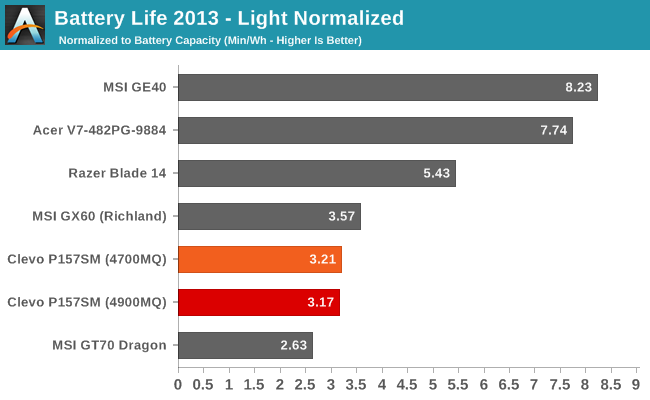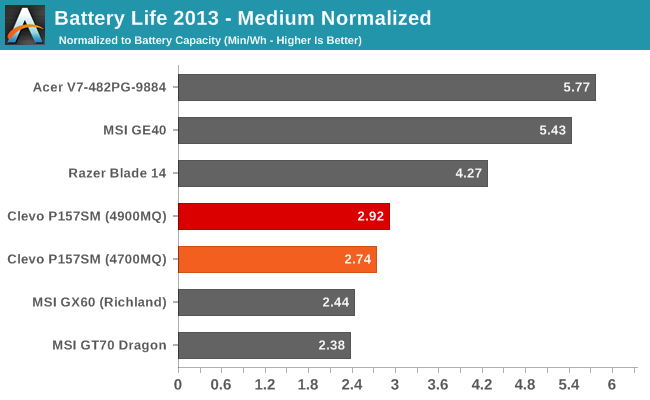Mythlogic Pollux 1613 / Clevo P157SM Review
by Jarred Walton on August 30, 2013 12:00 AM ESTMythlogic Pollux 1613 / Clevo P157SM Battery Life
If there’s one weak spot in terms of objective measurements with Clevo’s gaming notebooks, it’s almost always battery life. Regardless of what power profile or other settings you might use, it’s simply not as good as what we’ve seen with gaming notebooks from other vendors. Most of this is due to the tuning of the BIOS/firmware with a focus on performance rather than power efficiency.
The scores in the charts below include our initial testing results from the MSI GT70, but as one example of what’s possible with further BIOS tuning, with an updated BIOS I measured 373/286/224 minutes on a GT70 – that’s a 63% improvement in our Light testing, a 38% improvement in our Medium testing, and a 23% improvement in our Heavy testing. Performance (gaming performance in particular) dropped slightly in most titles along the way, but reducing performance by a few percent to get significant increases in battery life is definitely a worthwhile compromise on a notebook. Whether or not Clevo can duplicate that feat with an updated BIOS remains to be seen, but past experience isn’t very encouraging.






The good news is that battery life is still better than what MSI achieved with our initial sample, but it’s a far cry from what we’ve seen with other laptops. MSI’s GE40 in particular delivered some stellar results, with relatively similar hardware all told (other than the smaller and lower quality display). Keep in mind that for all of these tests, the discrete GPU is inactive, so we’re only looking at the power and battery life with the iGPU and other components. Also interesting to note is that the choice of an i7-4700MQ or i7-4900MQ doesn't appear to impact battery life much at all.
I’m always asked for battery life while gaming, so I did run some tests there as well. First, as with most gaming notebooks, the dGPU throttles pretty heavily under load. I looped 3DMark11’s demo at 1366x768 “Performance” settings until the battery went dead, and frame rates were around 30-50% of what you’d get while on AC power. The GPU clocks in a game are 850MHz+ on the core and 5000MHz on the GDDR5; unplug the notebook and the core clocks drop to 405MHz while the RAM drops to 1600MHz – not that you need 5000MHz RAM to feed a 405MHz core, but it’s still a major castration of performance under battery power. What that means is that you can actually get nearly the same gaming performance on battery power from the Acer V7 with its GT 750M (which doesn’t throttle as much), or the MSI GE40 (again, less throttling).
Battery life of course is going to be better than if you were running the GPU full tilt, but even with the reduce clocks the P157SM only manages 75-80 minutes before the battery is drained. Put another way, unplugged and running a game the P157SM draws about 63W. Plugged in, I measured 185W power draw at the outlet, so even if we assume an 80% efficiency power brick (and hopefully it’s better than that), the laptop is using around 150W when plugged in, or more than twice as much power. Would someone be happy to get twice the performance but less than half the battery life with a gaming notebook? I doubt it, so the decision to throttle the GPU clocks on DC power is probably the right thing to do.










47 Comments
View All Comments
GTVic - Saturday, August 31, 2013 - link
Obvious answer is the tradeoff with the weight. If you overclock to the extent that you need 220W+ then you are going to need heavier duty cooling design which adds even more weight.Khenglish - Saturday, August 31, 2013 - link
The 15" and 17" laptops both have identical motherboards with Identical cooling (the 15" has a default aluminum CPU radiator, but most resellers offer the copper version found in the 17")So no there would be no extra weight.
waldojim42 - Friday, August 30, 2013 - link
I, for one, am always glad to see high end displays in use. Props to Clevo for such a decent display.On your last page, you mention wanting to test against the Alienware 17. While I understand the reasoning, I think that Alienware/Dell put the majority of their focus on the 14 and 18 this time around. Both the 14 and 18 have high end display options that the 17 doesn't get. IPS, and PLS to be exact. Frankly, I would be far more interested in your results on those over the 17" TN panel.
Also, I have a 9700QM based machine being delivered later this week - one thing I didn't see mentioned, was the thermal impact from overclocking. Also, is the 2bin OC limit an Intel limit, or BIOS limit? I know the machine I am picking up is supposed to allow overclocking, but I prefer not to go into these things blindly - and there really isn't a lot of good information on this.
JarredWalton - Friday, August 30, 2013 - link
I honestly don't know if the limit is BIOS or Intel, but I suspect it might be BIOS. Usually, Intel lets you do +4 bins, and you can set SC, DC, TC, QC to the same multiplier (basically, what I could do with the 4900MQ). But perhaps Intel locked down the 4700MQ for precisely the reason that it would be nearly the same as a 4900MQ if you could set everything to 3.8GHz. Thermally, the 4700MQ didn't have any issues overclocked, but the 4900MQ behaved oddly; I think I need to tweak the OC settings to get more out of it, and even then I think it will only be at best a 3-5% improvement over stock clocks.Finally, regarding Alienware, the 18 is hard for me to go for, as it's so huge -- it's in the same category as the Clevo P370SM. I'm just not sold on SLI for notebooks, as there are too many gotchas (heat, size, drivers, cost, etc.) I didn't realize the AW 17 didn't do anything more for the display; I was hoping to see IPS/AVHA/PLS in there, but I guess not? Maybe next time; anyway, Dustin has the full review in the works, but the high gamut TN panel in the Clevo's is getting somewhat out of date.
Meaker10 - Friday, August 30, 2013 - link
4700 = +2004800 = +400
4900 = +600
4930 = unlocked
4.2ghz on all cores is a +600mhz boost to the core ratio:
4900 = 38/37/36/36 (4core/3core/2core/1core turbo max)
4990 oc max = 44/43/42/42
The biggest restriction on the 4900 and 4800 will be that tdp increases are locked to +10w to 57w so going beyond 3.9ghz wont mean much (setting anything higher than 57w may looks like it has set but the cpu power wont go beyond 57w).
Also powernotebooks is niw selling a 4.1ghz oced 4939mx and 3.9ghz 4900mq in the msi barebone range. How many times do we have to tell you your machine was a bad sample?
kogunniyi - Friday, August 30, 2013 - link
You're right, but MSI deserves some flack for sending Anandtech two bad samples.DanNeely - Friday, August 30, 2013 - link
They've gotten a good one; hopefully at part of one of their upcoming articles they'll publish updated thermals. Unless the issue was a, now fixed, design flaw/fan controller bug though 2 faulty laptops in a row suggests serious QA problems that would scare me away.JarredWalton - Friday, August 30, 2013 - link
Anyone that thinks the MSI was a "bad sample" at this point is fooling themselves. You can keep "telling us we had a bad sample", but that just isn't true. Dustin had one MSI notebook, and at full load it hit 96C on the CPU (unless you trigger the max fan tweak that turns it into a blow dryer). Then he sent that back, and NVIDIA sent me not one but two MSI GT70 notebooks for additional testing. Both of those hit 95C on the CPU under full load -- 10C hotter than the P157SM reviewed here. That said, the MSI notebooks I had from NVIDIA did not throttle -- they just ran hotter than I'd like. 95C is still less than the 100C max that Intel specifies, but how long will you be able to game on a notebook hitting such temperatures before things start going south?Could we replace the TIM to get reduced temperatures? Perhaps, but I just don't think that should be standard procedure, and it shouldn't be required in the first place. What's more, it still won't run as cool as the dual HSF Clevo designs, since it's cooling two power hungry chips with one fan.
As for the overclocking statements above, the maximum clock on the 4900MQ at stock is 3.8GHz, and pushing that to 4.2GHz was not stable (wouldn't even boot into Windows). While 4.4GHz is an option in theory, in practice I don't see it happening on any but the best CPUs. Even 4.0GHz is behaving oddly, with performance often lower than stock settings. I'm going to try a scaled OC of 4.1/4.0/3.9/3.8 to see if I can get any better performance than my initial results though....
Meaker10 - Friday, August 30, 2013 - link
The thing is to go beyond 3.9ghz you will start having to add voltage which will instantly slam you into the 57W TDP limit. It looks like you were already hitting into it anyway.This is an even more delicate operation than a mITX desktop after all but can be done if you are patient.
But by your own admission if throttle was not occurring on the sager then temps would likely be in the same area and the dual fan has no advantage....
JarredWalton - Friday, August 30, 2013 - link
Temperature and power draw are different, so the 57W TDP is the factor. The Sager can better dissipate that (keeping the CPU at <90 and usually <85, with the GPU <80), but Intel's preventing higher Turbo even at lower temperatures. The MSI isn't throttling, meaning, it's not dropping below the rated speed, but it's also not running at max Turbo either. There's a difference.